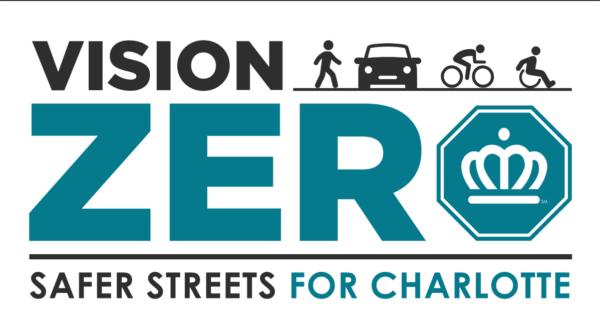How can the City make progress on Vision Zero? New audit offers concrete steps

On July 25, the City of Charlotte Internal Audit Department released a Vision Zero Audit. The audit was conducted to find out what exactly the city is doing to make sure we reach our Vision Zero goals. But first:
What is Vision Zero?
Vision Zero is an international “strategy to eliminate all traffic fatalities and severe injuries, while increasing safe, healthy, and equitable mobility for all” (Vision Zero Network). While this may seem like a lofty goal, several cities both around the world and here in the United States have reached it, including Oslo, Norway and Hoboken, NJ, just across the river from New York City.
In 2019, Charlotte joined more than 50 other U.S. cities in adopting the Vision Zero program. At the time, City Council set an ambitious goal to eliminate all traffic deaths and serious injuries by 2030 and created an action plan to achieve that goal.
Sustain Charlotte was instrumental in gathering public support for the Vision Zero program adoption in 2019 and continues to serve on the Vision Zero Task Force and monitor progress.
Why does it matter?
Historically, Charlotte was designed for cars, and more specifically for moving cars quickly. Unfortunately, this prioritization of speed often leads to crashes, both with other vehicles, stationary objects, and most fatally, people. In 2023, Charlotte reported 393 crashes between cars and people walking and on bikes. Of those, 26 were fatal. That’s 26 people who needlessly lost their lives in our city last year. Vision Zero aims to change the car-centric narrative and prioritize safety on our streets, not speed.
What are the key takeaways from the Vision Zero Audit?
- Charlotte Department of Transportation (CDOT) has not fully implemented some key components of the Vision Zero Action Plan
- City employees’ Vision Zero-related safety behaviors are not monitored.
- CMPD’s enforcement operations are scheduled and distributed evenly around the City rather than by the severity of each corridor’s crash history and killed or severely injured (KSI) score.
- CMPD does not consistently enter complete and accurate data into the NC DMV-349 crash forms.
- Crashes’ contributing factors are not considered in the development of the High Injury Network.
- CMPD enforcement efforts have not been consistent and sustained.
Our take on the Vision Zero Audit
We support all the recommendations in this report and are pleased that CDOT and CMPD have agreed to implement them.
Over the last century, billions of dollars have been spent on building a transportation system in Charlotte designed to prioritize moving vehicles as quickly as possible rather than ensuring the safety of all road users. Most crashes, including those that kill or seriously injure people, are due to roads designed to maximize vehicle speed rather than safety.
As noted in the report, without a change in state laws that would allow automated enforcement such as red light cameras, which we support, achieving lasting impacts from existing enforcement activities will not be achieved. Strategic enforcement by CMPD will help but redesigning dangerous roads to make speeding more difficult will have a greater long-term impact.
The list of road projects that CDOT would like to implement to improve safety is long, but the funding available is not enough to build these projects at the required rate. With the additional one-cent sales tax for transportation, these projects could be built faster. It is also critical that these investments be made strategically so that the roads with the highest number of fatalities and serious injuries are fixed first. In addition to more funds, implementing these projects will require political will and a shift in our current car-oriented culture.
At the same time, low-cost approaches can be taken to slow vehicles and improve safety for all users. Re-allocating existing road space by narrowing travel lanes, reducing the number of lanes, and adding separated bike lanes are just a few examples. The City has done this on a number of roads, but more is needed. Policy changes such as banning right turns on red lights, at least at intersections on the high-injury network, would also make a difference at a relatively low cost.
As the report mentions, 62% of Charlotte’s KSI crashes over the past ten years occurred on state-maintained roads. We urgently need NCDOT, who has also committed to Vision Zero, to do their part and work with the City to save lives. In addition to the small number of projects being funded by the Vision Zero program, we need the safety of all users to be the priority for every road managed by the city and state. That isn’t currently happening. Many of our local and state roads are still being designed to move vehicles as quickly and efficiently as possible.
We strongly support these recommendations as well:
- Designating someone to oversee the Vision Zero program and action plan.
- Establishing and reporting on Vision Zero performance goals metrics at least once per year.
- Ensuring accurate data collection about where crashes are occurring and the cause.
- Eliminating sidewalk and bike path obstructions.
In case you missed it
Sustain Charlotte team members were interviewed by local media as thought-leaders on the issue.
- Charlotte spent millions, but traffic deaths, injuries aren’t going down, new audit finds | The Charlotte Observer
- Charlotte’s Vision Zero program in the spotlight after ‘deeply troubling’ audit | WCNC
- City of Charlotte not doing enough to eliminate deadly crashes, audit says | WSOCTV
Thanks for reading!
As a nonprofit, community support is essential for us to keep doing what we do — including providing free articles like this. If you found this article helpful, please consider supporting Sustain Charlotte.
Want to stay in the loop? Subscribe to our weekly newsletter and follow us on Instagram, Facebook, and X.
